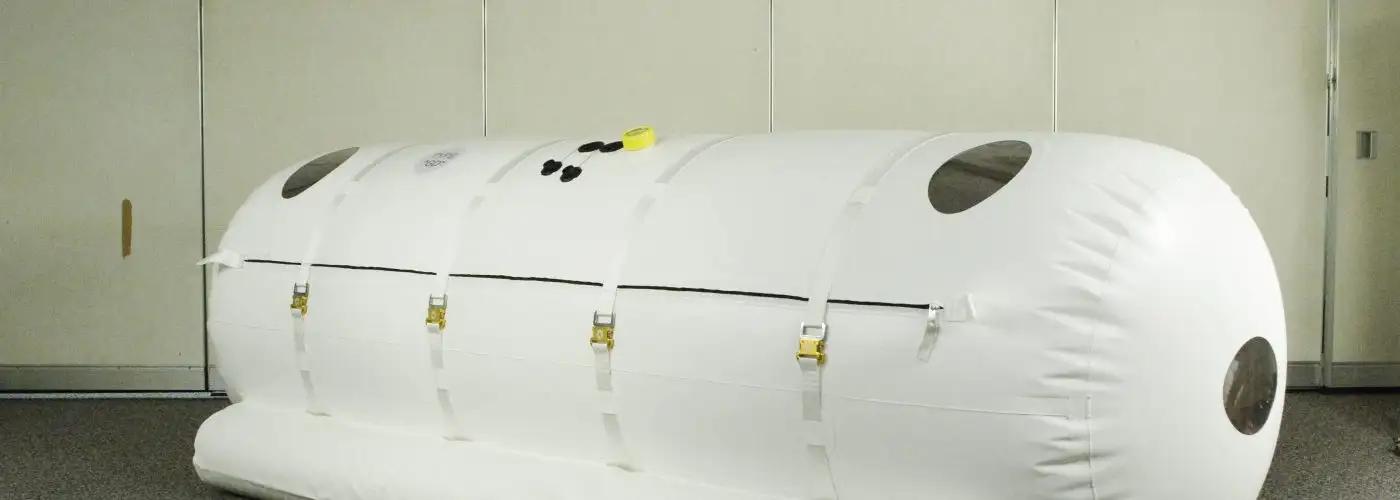I’m always on the lookout for jet lag remedies, so when I learned about mild hyperbaric oxygen treatment as a growing trend for treating the ill-effects of air travel and time-zone changes, I knew I wanted to test it out. Here’s the lowdown on my experience.
Inflight Air Pressure
Airplane cabins are pressurized so that when you’re at cruising altitude (36,000 to 40,000 feet), the air pressure in the cabin is equal to about what you’d experience at 6,000 to 8,000 feet above sea level. The reduced air pressure means the amount of oxygen in your blood is lower than it would be at sea level.
(Here’s cabin air pressure explained by the World Health Organization).
If you’ve ever spent time at high altitudes, you’re likely familiar with the fatigue, headaches, and insomnia that come with reduced oxygen. Add this to the dehydration of air travel and the challenge of shifting time zones and it begins to make sense why jet lag is such a beast.
Hyperbaric Oxygen Treatment Chamber Air Pressure
While airplane cabin air pressure is lower than sea-level air pressure, air pressure inside the hyperbaric oxygen chamber is higher—by two to three times. Mild hyperbaric oxygen chamber treatment, or mHBOT, involves breathing pure oxygen in a pressurized tube, allowing your lungs to gather more oxygen than it gets from breathing pure oxygen at regular air pressure. This helps your blood deliver more oxygen to your organs and tissues, and can help, according to Mayo Clinic, “fight bacteria and stimulate the release of substances called growth factors and stem cells, which promote healing.”
As the trend of mHBOT grows, so do concerns about it being sold as an off-label miracle cure for conditions ranging from autism to cancer. That said, it’s been successfully used for many years by college and pro athletes, who use the method to recover from workouts, heal from injuries faster, and reduce the effects of jet lag while traveling between games.
The Process
Receiving mild hyperbaric oxygen treatment requires a prescription. In my phone consultation with the doctor (the treatment clinic referred me to a doctor who did a phone consultation) we discussed mHBOT. I wanted to use it right after landing after my return flight home for both jet lag and muscle soreness, since I was anticipating—correctly—muscle pain from a trip spent cycling, kayaking, and hiking.
The Hyperbaric Oxygen Treatment Experience
After an 11-hour flight, I went home, had a light meal and a quick shower, and then headed to a clinic called Holistic Hyperbarics for a 90-minute session.
I am mildly claustrophobic, so I had some concerns about being in the hyperbaric chamber. But Alex Williams, who runs the clinic (who I know and who offered me the treatment), calmly talked me through the process and then helped me get comfortable and oriented inside the chamber. While it wasn’t big, it was roomy enough that I could prop myself up on my elbows inside and still have a bit of headspace. The chamber was outfitted with a little window, a comfortable mat for resting on, pillows for my head and under my knees, a remote-control fan and light, and a soft blanket (everything is cleaned and sanitized for each patient).
The first few minutes were spent chewing gum and popping my ears as the chamber pressurized. Once the pressure in my ears equalized, I got more comfortable. After a 16-hour travel day, it was easy to fall asleep, and I slept deeply for the length of the treatment. When I woke up, it was time to depressurize, a process that lasted about 10 minutes and allowed my body to readjust to the exterior air pressure. After I exited the chamber, I had the juice and vitamins offered as part of the treatment package, and then headed home.
Jet Lag Recovery Time
I spent the next week monitoring the jet lag differences between myself and my husband, who had traveled with me but who stayed home to watch the kids while I underwent the mHBOT session. For the first day, we were both feeling pretty rough—exhausted at the wrong time of day and headachy. But I immediately started sleeping through the night, while he was plagued by 3 a.m. wakeups. About three days post-travel, I felt almost normal again, while he continued to feel the ill-effects of jet lag for more than a week. And while we’re different people with different reactions to jet lag, I did feel like my recovery time was faster than it has been on recent trips with the same time-zone change.
Would I do it again? Yes. Jet lag is terrible, and while the treatment didn’t erase it entirely, I did bounce back significantly faster than my control subject, who, after 10 days, is still falling asleep at 8 p.m. most nights.
More from SmarterTravel:
- 9 Products to Help You Stay Healthy While Traveling
- 18 Easy Ways to Have a Better Flight
- 9 Ways to Sleep Better on Overnight Flights
We hand-pick everything we recommend and select items through testing and reviews. Some products are sent to us free of charge with no incentive to offer a favorable review. We offer our unbiased opinions and do not accept compensation to review products. All items are in stock and prices are accurate at the time of publication. If you buy something through our links, we may earn a commission.
Related
Top Fares From
Today's Top Travel Deals
Brought to you by ShermansTravel
Shop and Save with Country Inns...
Patricia Magaña
 Hotel & Lodging Deals
Hotel & Lodging Deals
$229 -- Chicago: Discounted Rates and...
Francesca Miele
 Hotel & Lodging Deals
$229+
Hotel & Lodging Deals
$229+
$188 -- Honolulu: Save on Oceanview...
Abigail Lamay
 Hotel & Lodging Deals
$188+
Hotel & Lodging Deals
$188+




